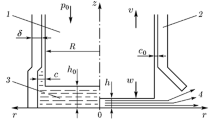Abstract
The disintegrating-shell method, which was developed for tests of initiating high-explosives (HE), is used for studying the susceptibility of secondary HE to mechanical actions. The critical pressures at which a number of HE with a different level of susceptibility (from lead azide to TNT) explode are measured. The relative series of critical pressures of explosion excitation that allows one to compare the susceptibility of the initiating and secondary HE is obtained with the use of the results of the tests performed within the framework of one experimental method.
Similar content being viewed by others
References
Recommendations on the Transport of Dangerous Goods. Manual Tests and Criteria, Second revised editions United Nations, New York-Geneva, (1995).
Explosives. Methods of Determining the Impact Susceptibility, GOST 4545-80, State Committee of Standards of the USSR, Moscow (1981).
G. T. Afanas'ev and V. K. Bobolev,Impact Initiation of Solid Explosive [in Russian], Nauka, Moscow (1968).
G. T. Afanas'ev, V. K. Bobolev, Yu. F. Karabanov, and V. G. Shchetinin, “Fracture and initiation of a thin layer of HE on impact,”Fiz. Goreniya Vzryva,11, No. 3, 467–475 (1975).
V. A. Sukhikh and Yu. B. Khariton, “Emergence of flashes in an explosive upon short-term strains,” in:Problems of the Theory of Explosives [in Russian], No. 1, Izd. Akad. Nauk USSR, Moscow-Leningrad (1947), pp. 149–154.
F. F. Bowden and A. Yoffe,Initiation and Growth of Explosion in Liquids and Solid, Cambridge Univ. Press (1952).
V. G. Shchetinin, “Estimate of the heating of solids on a friction surface,”Khim. Fiz.,19, No. 5, 688–692 (1983).
I. S. Grigor'ev and E. Z. Meilikhov (eds.),Physical Quantities: Handbook [in Russian], Énergoizdat, Moscow (1991).
V. G. Shchetinin, “Critical conditions for excitation of an explosion of solid explosives,”Dokl. Akad. Nauk SSSR,258, No. 4, 865–867 (1981).
G. T. Afanas'ev, V. I. Dolgov, and V. G. Shchetinin, “Initiation of an explosion during interaction between the elastic wave in an impactor and the quasistatic strain of a charge,” in:Detonation [in Russian], Chernogolovka, (1978), pp. 41–45.
G. T. Afanas'ev, V. K. Bobolev, V. I. Dolgov, et al., “Mechanical susceptibility of initiating explosives,” in:Combustion and Explosion, Proc. of IV All-Union Symp. [in Russian], Nauka, Moscow (1977), pp. 485–489.
L. M. Kachanov,Fundamentals of the Theory of Plasticity [in Russian], Nauka, Moscow (1969).
G. T. Afanas'ev, V. K. Bobolev, and V. I. Dolgov, “Excitation of an explosion of a solid HE upon deformation in a closed volume,”Fiz. Goreniya Vzryva,5, No. 4, 486–491 (1969).
A. V. Dubovik, “Thermal instability of the axial strain of a plastic layer and estimate of the critical pressures for impact initiation of solid HE,”Fiz. Goreniya Vzryva,16, No. 4, 103–109 (1980).
Author information
Authors and Affiliations
Additional information
Translated fromFizika Goreniya i Vzryva, Vol. 35, No. 5, pp. 116–121, September–October 1999.
Rights and permissions
About this article
Cite this article
Shchetinin, V.G. Estimation of the mechanical sensitivity of solid explosives by the disintegrating-shell method. Combust Explos Shock Waves 35, 570–575 (1999). https://doi.org/10.1007/BF02674504
Received:
Revised:
Issue Date:
DOI: https://doi.org/10.1007/BF02674504




